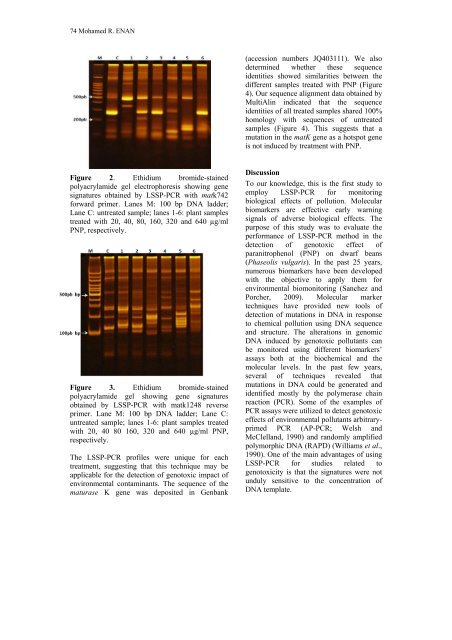10 2 Full Volume (PDF) - Journal of Cell and Molecular Biology ...
10 2 Full Volume (PDF) - Journal of Cell and Molecular Biology ...
10 2 Full Volume (PDF) - Journal of Cell and Molecular Biology ...
Create successful ePaper yourself
Turn your PDF publications into a flip-book with our unique Google optimized e-Paper software.
74 Mohamed R. ENAN<br />
Figure 2. Ethidium bromide-stained<br />
polyacrylamide gel electrophoresis showing gene<br />
signatures obtained by LSSP-PCR with matk742<br />
forward primer. Lanes M: <strong>10</strong>0 bp DNA ladder;<br />
Lane C: untreated sample; lanes 1-6: plant samples<br />
treated with 20, 40, 80, 160, 320 <strong>and</strong> 640 µg/ml<br />
PNP, respectively.<br />
Figure 3. Ethidium bromide-stained<br />
polyacrylamide gel showing gene signatures<br />
obtained by LSSP-PCR with matk1248 reverse<br />
primer. Lane M: <strong>10</strong>0 bp DNA ladder; Lane C:<br />
untreated sample; lanes 1-6: plant samples treated<br />
with 20, 40 80 160, 320 <strong>and</strong> 640 µg/ml PNP,<br />
respectively.<br />
The LSSP-PCR pr<strong>of</strong>iles were unique for each<br />
treatment, suggesting that this technique may be<br />
applicable for the detection <strong>of</strong> genotoxic impact <strong>of</strong><br />
environmental contaminants. The sequence <strong>of</strong> the<br />
maturase K gene was deposited in Genbank<br />
(accession numbers JQ403111). We also<br />
determined whether these sequence<br />
identities showed similarities between the<br />
different samples treated with PNP (Figure<br />
4). Our sequence alignment data obtained by<br />
MultiAlin indicated that the sequence<br />
identities <strong>of</strong> all treated samples shared <strong>10</strong>0%<br />
homology with sequences <strong>of</strong> untreated<br />
samples (Figure 4). This suggests that a<br />
mutation in the matK gene as a hotspot gene<br />
is not induced by treatment with PNP.<br />
Discussion<br />
To our knowledge, this is the first study to<br />
employ LSSP-PCR for monitoring<br />
biological effects <strong>of</strong> pollution. <strong>Molecular</strong><br />
biomarkers are effective early warning<br />
signals <strong>of</strong> adverse biological effects. The<br />
purpose <strong>of</strong> this study was to evaluate the<br />
performance <strong>of</strong> LSSP-PCR method in the<br />
detection <strong>of</strong> genotoxic effect <strong>of</strong><br />
paranitrophenol (PNP) on dwarf beans<br />
(Phaseolis vulgaris). In the past 25 years,<br />
numerous biomarkers have been developed<br />
with the objective to apply them for<br />
environmental biomonitoring (Sanchez <strong>and</strong><br />
Porcher, 2009). <strong>Molecular</strong> marker<br />
techniques have provided new tools <strong>of</strong><br />
detection <strong>of</strong> mutations in DNA in response<br />
to chemical pollution using DNA sequence<br />
<strong>and</strong> structure. The alterations in genomic<br />
DNA induced by genotoxic pollutants can<br />
be monitored using different biomarkers’<br />
assays both at the biochemical <strong>and</strong> the<br />
molecular levels. In the past few years,<br />
several <strong>of</strong> techniques revealed that<br />
mutations in DNA could be generated <strong>and</strong><br />
identified mostly by the polymerase chain<br />
reaction (PCR). Some <strong>of</strong> the examples <strong>of</strong><br />
PCR assays were utilized to detect genotoxic<br />
effects <strong>of</strong> environmental pollutants arbitraryprimed<br />
PCR (AP-PCR; Welsh <strong>and</strong><br />
McClell<strong>and</strong>, 1990) <strong>and</strong> r<strong>and</strong>omly amplified<br />
polymorphic DNA (RAPD) (Williams et al.,<br />
1990). One <strong>of</strong> the main advantages <strong>of</strong> using<br />
LSSP-PCR for studies related to<br />
genotoxicity is that the signatures were not<br />
unduly sensitive to the concentration <strong>of</strong><br />
DNA template.
















